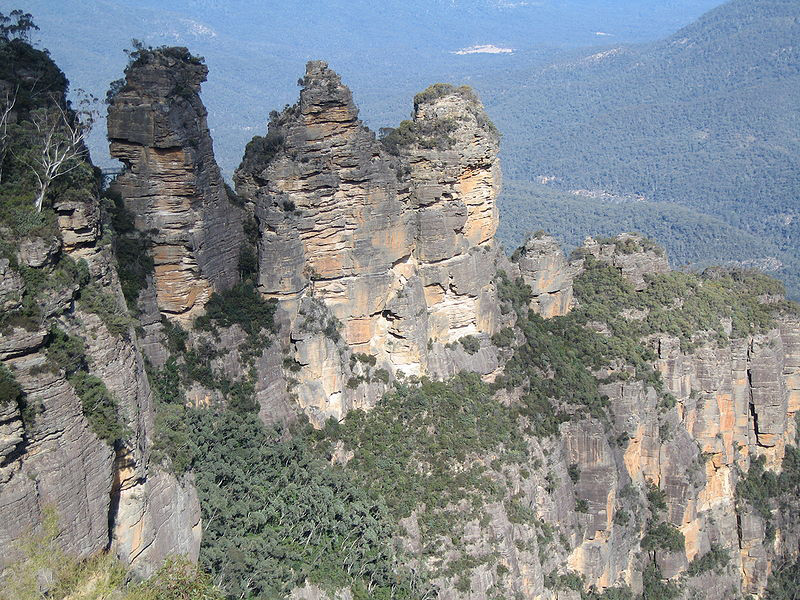
The Three Sisters, Katoomba, Blue Mountains, NSW, Australia
In 1868 a railway line was completed from Sydney to Katoomba, the largest Blue Mountains town. Sydneysiders were quick to recognize the great attractions of the area (for example, the stunning views and the clean air) and flocked to holiday and health resorts that were built in the mountain towns such as Katoomba, Medlow Bath and Wentworth Falls. Some of these 19th century resorts (such as the Carrington Hotel, Katoomba and the Hydro Majestic Hotel, Medlow Bath) still exist and welcome visitors.
The Blue Mountains National Park was proclaimed and in 2000 the Blue Mountains were listed by UNESCO as a World Heritage Site.
Thousands of bushwalkers, hikers, mountain climbers, abseilers and general nature lovers visit towns in the Blue Mountains National Park such as Katoomba, Leura, Medlow Bath, Blackheath, and Mt Victoria. From these towns they can, for example, go on short or long bushwalks in the surrounding pristine forests.
Many day tripper tourists just visit the Blue Mountains to visit Katoomba and its natural wonders, the Three Sisters, Echo Point, The Giants Stairway, and the Jamieson Valley.
For the person with more time, other parts of the Blue Mountains are definitely worth visiting, such as Springwood and Glenbrook in the middle and lower areas of the mountains.
The Blue Mountains have had many appreciative visitors over the years. However, it seems that the famous English biologist, Charles Darwin, who visited Sydney in 1836 during his scientific circumnavigation of the world in the H.M.S. Beagle and who also crossed the Blue Mountains during his stay, was not one of them! He wrote:
"From so grand a title as Blue Mountains, and from their absolute altitude, I expected to have seen a bold chain of mountains crossing the country; but instead of this, a sloping plain presents merely an inconsiderable front to the low land near the coast. From this first slope, the view of the extensive woodland to the east was striking, and the surrounding trees grew bold and lofty. But when once on the sandstone platform, the scenery becomes exceedingly monotonous; each side of the road is bordered by scrubby trees of the never-failing Eucalyptus family; and with the exception of two or three small inns, there are no houses or cultivated land: the road, moreover, is solitary; the most frequent object being a bullock-waggon, piled up with bales of wool".
The great Australian conservationists, Myles Dunphy (1891-1985) and his son Milo Dunphy (1928-1996), however, saw the Blue Mountains with different eyes. They saw the great and unspoilt beauty of the Greater Blue Mountains Area -- its beautiful eucalyptus forests, its gorges, its swamps, its valleys, all teeming with life and with rare species.
Myles proposed as early as 1932 that a Greater Blue Mountains National Park should be declared -- this area would include the areas that are now known as the Blue Mountains National Park, the Wollemi National Park, the Kanangra-Boyd National Park, and the Nattai National Park. The Blue Mountains National Park was finally declared in 1959, and in 2000 it became part of the UNESCO-listed Greater Blue Mountains World Heritage Area.
Share this page:
Author: David Paul Wagner
(David Paul Wagner on Google+)